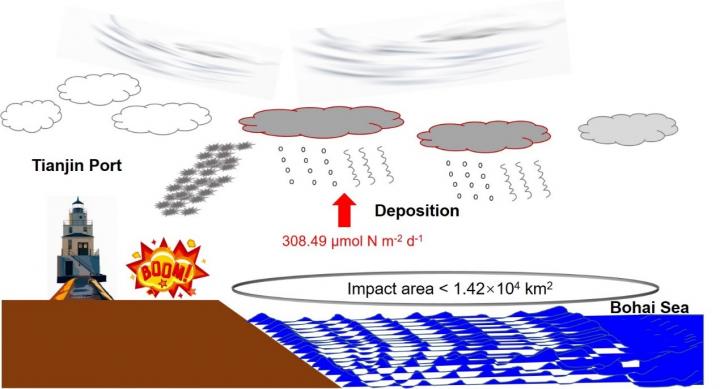
Credit: Zheng Zong
Total production and the scale of industrial enterprises in China have expanded greatly since late 1970s. As such, the long-term accumulated environmental risks have evolved and intensified, and China has entered a period of high incidence of environmental pollution events. In August 2015, a serious explosion occurred in Tianjin Port, leaving at least 50 dead and hundreds injured. Fire and smoke soared into the skies of Tianjin.
According to the characteristics of the large-scale airflow field at that time, a large amount of nitrogen-containing pollutants generated by the explosion were transmitted to the Bohai Sea. The increase of nitrate or phosphate in the water encourages the growth of algae which starts eutrophication process, also known as “well-nourished” – with excess nutrients. However, the impact of these nitrogenous substances on the Bohai Sea region remains unclear.
Dr. Zheng Zong and coauthors from Yantai Institute of Coastal Zone Research, Chinese Academy of Sciences, confirmed and evaluated the effects of the Tianjin Port explosion on the atmospheric nitrogen deposition in the Bohai Sea area. The work was based on the nitrogen and oxygen isotopes of the aerosol nitrate on Beihuangcheng Island in the Bohai Strait, and is published in Atmospheric and Oceanic Science Letters.
According to this study, the nitrogen and oxygen isotopes were found to have a good response signal due to the explosion event: the nitrogen isotopic value in nitrate decreased significantly, while the oxygen isotopic value increased significantly; the explosion and fire caused a large increase in atmospheric nitrogen deposition in the Bohai Sea area, by 308.49 micromole N per square meter per day, in which the nitrate nitrogen deposition accounted for 86.25%.
“We calculated the atmospheric nitrogen deposition and the total explosive nitrogen, and estimate that the impact area of the explosion on the Bohai Sea is about 1/5 of the total area of the Bohai Sea,” says Dr. Zong.
###
Media Contact
Zheng Lin
[email protected]
86-108-299-5053
Original Source
http://english.
Related Journal Article
http://dx.




